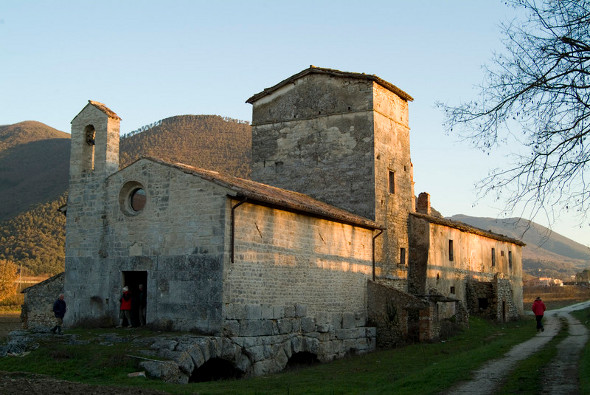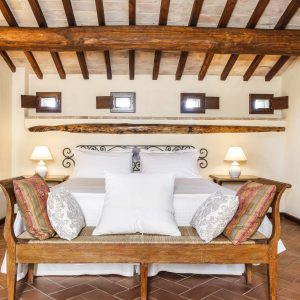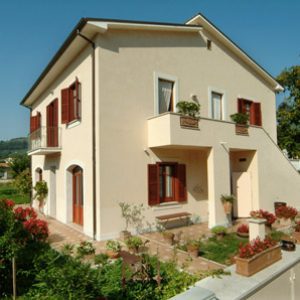▌ Alla scoperta di Acquasparta
#BELLAUMBRIA
{“translation”:[{“lang”:”it”,”content”:”
Situata sopra un colle a 350 m sul livello del mare, Acquasparta domina la valle del Naia, affluente del Tevere. Grazie alle sue acque minerali, la “Amerino” e la “Furapane” è una piacevolissima località di soggiorno.
Acquasparta nasce probabilmente come “pagus” romano lungo la via Flaminia: qui le truppe romane sostavano a rifocillarsi data proprio l’abbondanza di acqua, nonché la posizione rispetto alla strada. A sostegno di ciò è la presenza, appena sotto il paese, dei resti di un ponte romano, sul quale poggia la Chiesa di S. Giovanni in Butris costruita nel XV secolo e già di propietà dei cavalieri di Malta. All’interno del paese, l’edificio di maggiore importanza e’ senza dubbio il Palazzo Cesi , rinascimentale ed ottimamente conservato. Progettato nel 1564 da Gian Domenico Bianchi, e terminato presumibilmente intorno al 1579, il palazzo fu sede della prestigiosa Accademia dei Lincei, nonchè dimora del Duca Federico Cesi. Il palazzo è oggi spazio espositivo e sede per convegni.
>>Vuoi visitare Acquasparta? Consulta ora le offerte dei migliori agriturismi nelle vicinanze .
“},{“lang”:”en”,”content”:”
Situated on a hill at 350 m above sea level, Acquasparta dominates the valley of the Naia river, a tributary of the Tiber river. Because of its mineral waters Amerino and Furapane , this is at very pleasant place to stay.
Probably, Acquasparta was founded as a Roman pagus on the Flaminia Road: here the Roman troups stopped to refresh themselves because of the abbundance of water, and because of its vicinity to the road. The remains of a Roman bridge, on which the church of , constructed in the 15th century and already at that time property of the Knights of Malta had been erected, support this thesis. Without doubt, the most important building inside the town is the dating back to the Renaissance and beautifully preserved. Planned in 1564 by Gian Domenico Bianchi, and probably finished at about 1579, the palace was the seat of the prestigious Accademia dei Lincei, and also the residence of Duke Federico Cesi
Today, exhibitions and meetings are held in the palace. The church of San Francesco, simple and charming with its Romanic-Gothic architecture typical of the Francescan churches in Umbria, the church of the Madonna of the Lily (or of the Cross), constructed in 1606, the church of St. Cecily, reconstructed in about the 15th century above another church dating back to the 13th century, and the church of the Sacred Sacrament,which is a minor jewel of 17th century architecture, with an important Roman mosaic incorporated inside in its pavement, are all of particular interest. The representation of the Living Theater in the historical town center is a tradition of Acquasparta which is much followed (held at Christmas, at the New Year and at the feast of the Epiphany).
“},{“lang”:”fr”,”content”:”
Située sur une colline à 350 mètres au-dessus du niveau de la mer, Acquaspartadomine la vallée du Naia, affluent du Tevere. Grâce à ses eaux minérales, “Amerino” et la “Furapane”, c’est une agréable localité de séjour.
Acquasparta est probabòement née sous le nom romain de “pagus”, le long de la voie Flaminia: ici les troupes romaines s’arrêtaient pour se ressourcer étant donnél’abondance de l’eau, ainsi que la position par rapport à la route. Ceci est démontré par la présence, juste en bas du village, des restes d’un pont romain sur lequel s’appuie l’église de St. Giovanni in Butris, contruite au XVème siècle et déjà propriété des Chevaliers de Malte.
A l’intérieur du village, l’édifice le plus important est sans aucun doute le Palazzo Cesi, datant de la Renaissance et très bien conservé. Projeté en 1564 par Gian Domenico Bianchi et terminé probablement aux alentours de 1579, l’édifice fût le siège de la prestigieuse Académie des Lincei, ainsi que la demeure du Duc Federico Cesi. Le palais est aujourd’hui un espace d’exposition et le siège de congrès.
Sont également intéressantes l’église de Saint François, simple et authentique dans se lignes romanico-gotiques charactéristiques des églises franciscaines ombriennes, l’église de la Madonna du Giglio (ou du Crucifix), construite en 1606, l’église de Sainte Cécile, reconstruite aux alentours du XVème siècle sur une précédente église du XIIIème siècle, et l’église du St.
Sacrement, petit joyaux d’architecture du XVIIème siècle, avec à l’intérieur une précieuse mosaïque romane encastrée dans le sol. Traditionnelle et très suivie, à Acquasparta, est la Représentation du Théâtre Vivant à l’intérieur du Centre Historique (à Noël, Jour de l’An et Epiphanie).
“},{“lang”:”es”,”content”:”
Situated on a hill at 350 m above sea level, Acquasparta dominates the valley of the Naia river, a tributary of the Tiber river. Because of its mineral waters Amerino and Furapane , this is at very pleasant place to stay.
Probably, Acquasparta was founded as a Roman pagus on the Flaminia Road: here the Roman troups stopped to refresh themselves because of the abbundance of water, and because of its vicinity to the road. The remains of a Roman bridge, on which the church of , constructed in the 15th century and already at that time property of the Knights of Malta had been erected, support this thesis. Without doubt, the most important building inside the town is the dating back to the Renaissance and beautifully preserved. Planned in 1564 by Gian Domenico Bianchi, and probably finished at about 1579, the palace was the seat of the prestigious Accademia dei Lincei, and also the residence of Duke Federico Cesi.
Today, exhibitions and meetings are held in the palace. The church of San Francesco, simple and charming with its Romanic-Gothic architecture typical of the Francescan churches in Umbria, the churc
h of the Madonna of the Lily (or of the Cross), constructed in 1606, the church of St. Cecily, reconstructed in about the 15th century above another church dating back to the 13th century, and the church of the Sacred Sacrament,which is a minor jewel of 17th century architecture, with an important Roman mosaic incorporated inside in its pavement, are all of particular interest. The representation of the Living Theater in the historical town center is a tradition of Acquasparta which is much followed (held at Christmas, at the New Year and at the feast of the Epiphany).
“},{“lang”:”de”,”content”:”
Situated on a hill at 350 m above sea level, Acquasparta dominates the valley of the Naia river, a tributary of the Tiber river. Because of its mineral waters Amerino and Furapane , this is at very pleasant place to stay.
Probably, Acquasparta was founded as a Roman pagus on the Flaminia Road: here the Roman troups stopped to refresh themselves because of the abbundance of water, and because of its vicinity to the road. The remains of a Roman bridge, on which the church of , constructed in the 15th century and already at that time property of the Knights of Malta had been erected, support this thesis. Without doubt, the most important building inside the town is the dating back to the Renaissance and beautifully preserved. Planned in 1564 by Gian Domenico Bianchi, and probably finished at about 1579, the palace was the seat of the prestigious Accademia dei Lincei, and also the residence of Duke Federico Cesi.
Today, exhibitions and meetings are held in the palace. The church of San Francesco, simple and charming with its Romanic-Gothic architecture typical of the Francescan churches in Umbria, the church of the Madonna of the Lily (or of the Cross), constructed in 1606, the church of St. Cecily, reconstructed in about the 15th century above another church dating back to the 13th century, and the church of the Sacred Sacrament,which is a minor jewel of 17th century architecture, with an important Roman mosaic incorporated inside in its pavement, are all of particular interest. The representation of the Living Theater in the historical town center is a tradition of Acquasparta which is much followed (held at Christmas, at the New Year and at the feast of the Epiphany).
“}]}








